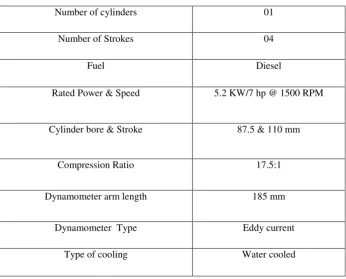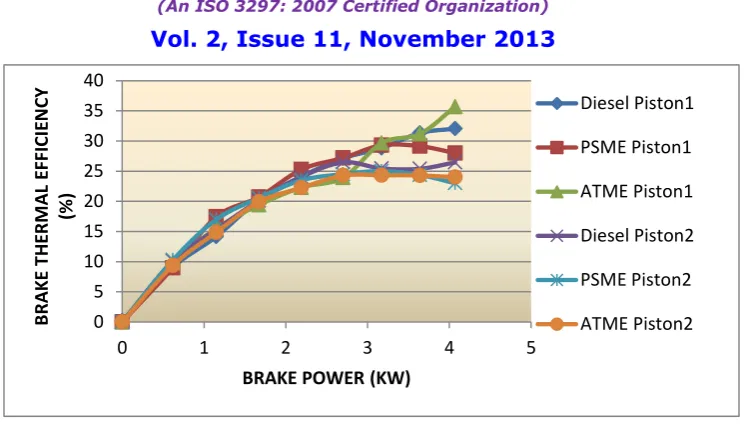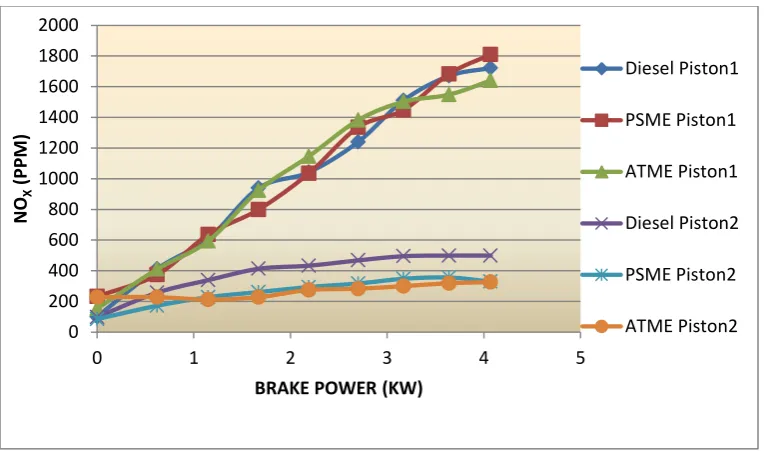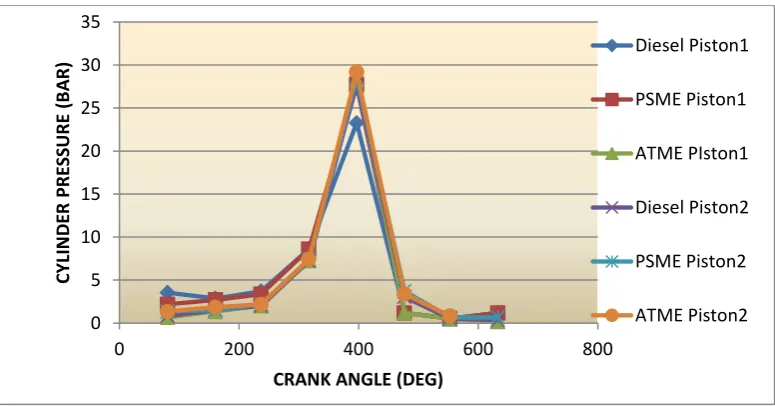ISSN: 2319-8753
I
nternational
J
ournal of
I
nnovative
R
esearch in
S
cience,
E
ngineering and
T
echnology
(An ISO 3297: 2007 Certified Organization)
Vol. 2, Issue 11, November 2013
Copyright to IJIRSET www.ijirset.com 6345
PERFORMANCE ANALYSIS OF
STATIONARY CI DIESEL ENGINE WITH
ASSORTED FUEL INJECTION
PRESSURES
M.Ravi
1, Dr.A.Aruna kumari
2, Dr.K.Vijaya Kumar Reddy
3M.Tech Student, Department of Mechanical Engineering, JNTU College of Engineering Hyderabad, Andhra Pradesh, India1.
Associate Professor, Department of Mechanical Engineering, JNTU College of Engineering Hyderabad, Andhra Pradesh, India2.
Professor, Department of Mechanical Engineering, JNTU College of Engineering Hyderabad, Andhra Pradesh, India3.
Abstract: The depletion, increasing demand and price of the petroleum prompted extensive research on biodiesel. There were several studies which indicate the significance of research on biodiesel as a substitute fuel to a diesel fuel. It has shown that biodiesel is one of the promising renewable, alternative and environmentally friendly biofuels that can be used in diesel engine with little or no modifications in the engine. The stringent emission laws, depletion of fossil fuels and relation of fuels with government policies have forced to the world to find alternatives to fossil fuels. Numerous vegetable oils enter have been investigated for use in internal combustion engines. The high viscosity and low volatility of these vegetables oils are the major problem for their use in the diesel engines. However use of different biodiesels in an engine results in variability in the engine performance and emission due to physical and chemical characteristics of fuel. The effect of these physio-chemical properties on fuel supply system such as fuel pump and fuel filter have already been reported. In this work an attempt is made to improve the combustion characteristics of the engine fueled with biodiesel. Hence a detailed investigation is carried out on the Underlying combustion and heat release characteristics. The experimental work is conducted on 4stroke, single cylinder, water cooled and Direct Injection stationary diesel engine. In this work bsfc and thermal efficiency are computed, for different in cylinder pressure and peak heat release rate
Key words: Biodiesel, Fuel Injection Pressure, bsfc, combustion characteristics.
I. INTRODUCTION
ISSN: 2319-8753
I
nternational
J
ournal of
I
nnovative
R
esearch in
S
cience,
E
ngineering and
T
echnology
(An ISO 3297: 2007 Certified Organization)
Vol. 2, Issue 11, November 2013
Copyright to IJIRSET www.ijirset.com 6346
high degree of atomization for better penetration of fuel in order to utilize the full air charge and to promote the evaporation in a very short time and to achieve higher combustion efficiency [6-8]. A large number of studies have shown that biodiesel is one of the promising renewable, alternative and environmentally friendly bio fuels that can be used in diesel engine [9]. Therefore the objective of this study is to investigate the performance, emissions and combustion characteristics of CI engine running with biodiesel [10].
II. MATERIALS AND METHODS
In this work we investigated the potential use of Palm Stearin Methyl Ester (PSME) and Animal Tallow Methyl Ester (ATME) as bio-diesels. Brief introductions about the material used in this work are given below.
Palm Stearin Methyl Ester (PSME)
Palm oilis processed into palm olein and palm stearin. Palm stearin is the solid fraction of palm oil that can be
Produced by partial crystallization at controlled temperature. It is more variable in composition than palm olein, the liquid fraction of palm oil, especially in terms of its solid fat content, and therefore has more variable physical characteristics. Palm oil with an estimated global (annual) production of 25-27 million tons is the second most produced oil in the world. By country, the leading producers of palm are Malaysia (13 million tons) and Indonesia (10 million tons), and together they have provided about 80% to 90% of the world's palm oil. Also among the various vegetable oils palm oil is the most available one. Palm oil is a vegetable oil which
Comes directly from plant seeds and it is mixed with alcohols such as ethanol and methanol by transeterification process from that biodiesel will be produced. Palm stearin methyl ester is used as alternate fuel for diesel engine which is refined from palm oil.
Animal Tallow Methyl Ester (ATME)
Animal Tallow used for production of Biodiesel, Animal Tallow can be used for biodiesel production as easily as Plant Oils. About 14 MT of Tallow is available globally. Tallow as a unique feedstock has certain properties that are hard to reproduce from plant oils.
The properties of palm stearin methyl ester, diesel and animal tallow methyl ester are given in following table1.
Table 1: Comparison of Properties of Palm Stearin Methyl Ester, Diesel and Animal Tallow Methyl Ester
Property Palm Stearin Methyl Ester
Diesel Animal Tallow Methyl Ester Density (gm/cc) at
30ºC
0.877 0.830 0.873 Viscosity (cst) 5.495 5.0 4.9 Flash Point (ºc) 220 57 175
Fire Point (ºc)
280 65 230 Calorific Value
(kj/kg))
ISSN: 2319-8753
I
nternational
J
ournal of
I
nnovative
R
esearch in
S
cience,
E
ngineering and
T
echnology
(An ISO 3297: 2007 Certified Organization)
Vol. 2, Issue 11, November 2013
Copyright to IJIRSET www.ijirset.com 6347
III. EXPERIMENTAL WORK
The Kirloskar engine is one of the widely used engines in agriculture pump sets, farm machinery and medium scale commercial purposes. The engine specifications are shown in table 2. The setup consists of a single cylinder, four strokes, naturally aspirated, water cooled Diesel engine connected to eddy current dynamometer. This eddy current dynamometer is used for loading the engine. The engine is interfaced with Engine Soft Software for the measurement of combustion parameters. It is provided with necessary instruments for Combustion chamber pressure and crank-angle measurements. For the measurement of cylinder pressure, a pressure transducer is fitted on the engine cylinder head and a crank angle encoder is used for the measurement of crank angle and TDC position. The pressure and crank angle signals are fed to a data acquisition card fitted with Pentium 4 personal computer. The engine speed is sensed and indicated by an inductive pick up sensor in conjunction with a digital rpm indicator, this is a part of eddy current dynamometer. The liquid fuel flow rate is measured on the volumetric basis using a burette and a stopwatch. Provision is also made for interfacing airflow, temperatures and load measurement. The airflow is measured using an orifice meter and the exhaust gas temperatures are recorded with thermocouples. The set up has stand-alone panel box consisting of air box, fuel tank, manometer, fuel measuring unit, Transmitters for air and fuel flow measurements, process indicator and engine indicator. Rotameters are provided for cooling water and calorimeter water flow measurement. A computerized Diesel injection pressure measurement can be conducted through sensor transmitters. The various components of experimental set up are described below.Fig.1 shows line diagram of Experimental setup.
Table 2: Engine Specifications
Number of cylinders 01 Number of Strokes 04 Fuel Diesel
Rated Power & Speed 5.2 KW/7 hp @ 1500 RPM
Cylinder bore & Stroke 87.5 & 110 mm
Compression Ratio 17.5:1
Dynamometer arm length 185 mm
Dynamometer Type Eddy current Type of cooling Water cooled
ISSN: 2319-8753
I
nternational
J
ournal of
I
nnovative
R
esearch in
S
cience,
E
ngineering and
T
echnology
(An ISO 3297: 2007 Certified Organization)
Vol. 2, Issue 11, November 2013
Copyright to IJIRSET www.ijirset.com 6348
Figure 1: Line diagram of Experimental Setup
IV. RESULTS AND DISCUSSIONS
The experiments are conducted for variable loads like 0, 2, 4…up to 16 kg at engine speed of 1500 rpm for Hemispherical type piston and Flat type piston with injection pressures of 180,200,220,240 bar using fuels as Palm Stearin Methyl Ester (PSME), Animal Tallow Methyl Ester (ATME) and also on diesel with normal pressure on 4 stroke, single cylinder, water cooled, diesel engine connected to eddy current dynamometer in
Computerized mode in order to study the performance of engine. The performance parameters such as Brake Thermal
Efficiency (ηB.Th.), Brake Specific Fuel Consumption (bsfc) and Exhaust Gas Temperature (EGT).Emission parameters
such as Carbon Monoxide (CO), Carbon Dioxide (CO2), Un-burnt Hydro carbon (UHC), Nitrogen Oxides (NOx) and
oxygen (O2) and also combustion characteristics are evaluated in this project. These engine performances, emission
parameters and combustion characteristics of biodiesel are compared to those of pure diesel.
The Experimental Discussions for Engine Performance, Emissions Parameters and Combustion Analysis at different injection pressures of 180, 200, 220, 240 bars for Palm Stearin Methyl Ester, Animal Tallow Methyl Ester and Diesel for both Hemispherical and Flat Bowl Piston and the graphs which were drawn below are best at different injection pressures when compared with diesel.
Piston1-Hemispherical Type Piston
Piston2-Flat Type Piston
PSME- Palm Stearin Methyl Ester
ATME-Animal Tallow Methyl Ester
ISSN: 2319-8753
I
nternational
J
ournal of
I
nnovative
R
esearch in
S
cience,
E
ngineering and
T
echnology
(An ISO 3297: 2007 Certified Organization)
Vol. 2, Issue 11, November 2013
Copyright to IJIRSET www.ijirset.com 6349
Figure 2: Variation of Brake Thermal Efficiency with Brake Power at Injection Pressure of 240 bar
From the figures 2 it is observe that the Brake thermal efficiency for PSME flat piston at injection pressure of 240 bar has lower value of 23% compared to diesel this is due to lower momentum of very fine droplet penetration in combustion chamber and for ATME hemispherical piston has higher value which is 35.67% compared to diesel this is attributed to lower calorific value, lower viscosity coupled with density of fuel.
(ii). Brake specific fuel consumption
From the figure 3 it is notice that the bsfc for ATME hemispherical piston has lower value of 0.245 kg/kw-hr and for PSME flat piston is higher by 49.81% compared to diesel. This observed phenomenon is due to higher viscosity of fuel.
(iii). Exhaust Gas Temperature
From the figure 4 it is examine that Exhaust Gas Temperature for PSME hemispherical piston at a pressure of 200 bar has higher value compared to diesel and for ATME hemispherical piston at pressure of 240 bar has lower value compared to diesel therefore it will have higher performance due to reduction in exhaust heat loss.
B. Emission Parameters (i).Carbon Monoxide Emissions
From the figure 5 it is monitor that CO emissions for ATME flat piston at pressure of 200 bar has lower value and for ATME flat piston at a pressure of 240 bar is higher by 85.99% compared to diesel this is due to incomplete combustion of fuel.
0 5 10 15 20 25 30 35 40
0 1 2 3 4 5
B
R
A
K
E
TH
E
R
M
A
L
E
FFI
CIE
N
CY
(%
)
BRAKE POWER (KW)
Diesel Piston1
PSME Piston1
ATME Piston1
Diesel Piston2
PSME Piston2
ISSN: 2319-8753
I
nternational
J
ournal of
I
nnovative
R
esearch in
S
cience,
E
ngineering and
T
echnology
(An ISO 3297: 2007 Certified Organization)
Vol. 2, Issue 11, November 2013
Copyright to IJIRSET www.ijirset.com 6350
Figure 3: Variation of Brake Specific Fuel Consumption with Brake Power at Injection Pressure of 240 bar
Figure 4: Variation of Exhaust Gas Temperature with Brake power At Injection Pressure of 240 bar
0 0,2 0,4 0,6 0,8 1 1,2
0 1 2 3 4 5
B R A K E S PE CIFI C FU E L CON S UM PTI ON (K G/ K W -H R )
BRAKE POWER (KW)
Diesel Piston1 PSME Piston1 ATME Piston1 Diesel Piston2 PSME Piston2 ATME Piston2 0 100 200 300 400 500 600
0 1 2 3 4 5
E X H A US T GAS TE M PE R TA TU R E (0C)
BRAKE POWER (KW)
ISSN: 2319-8753
I
nternational
J
ournal of
I
nnovative
R
esearch in
S
cience,
E
ngineering and
T
echnology
(An ISO 3297: 2007 Certified Organization)
Vol. 2, Issue 11, November 2013
Copyright to IJIRSET www.ijirset.com 6351
Figure 5: Variation of CO with Brake Power at Injection Pressure of 240 bar
(ii).Carbon Dioxide Emissions
From the figure 6 it is perceive that PSME flat piston for 220 bar pressure has lower CO2 emissions compared to other
fuels and for PSME hemispherical piston at a pressure of 220 bar is higher by 38.21% compared to diesel. This is because of excess supply of oxygen is the influencing criterion.
Figure 6: Variation of C02 with Brake Power at Injection Pressure of 220 bar
(iii). Nitrogen Oxides Emissions
From the figure 7 it is inspect that PSME flat piston for 220 bar has lower emissions compared to other fuels at different pressures and for PSME hemispherical piston at rated load is higher by 11.59% compared to diesel. This is attributable to higher peak combustion temperature in the combustion chamber influences this factor.NOX increases for
biodiesel compared to diesel this is due to more oxygen content in the combustion chamber.
0 0,5 1 1,5 2 2,5
0 1 2 3 4 5
CO (
%
)
BRAKE POWER (KW)
Diesel PIston1
PSME Piston1
ATME Piston1
Diesel Piston2
PSME Piston2
ATME Piston2
0 2 4 6 8 10 12
0 1 2 3 4 5
CO
2
(%
)
BRAKE POWER (KW)
Diesel Piston1
PSME Piston1
ATME Piston1
Diesel Piston2
PSME Piston2
ISSN: 2319-8753
I
nternational
J
ournal of
I
nnovative
R
esearch in
S
cience,
E
ngineering and
T
echnology
(An ISO 3297: 2007 Certified Organization)
Vol. 2, Issue 11, November 2013
Copyright to IJIRSET www.ijirset.com 6352
(IV). Hydro Carbons Emissions
From the figure 8 it is recognize that HC increases at 180 bar for diesel, PSME, ATME for both hemispherical and flat pistons and at 200, 220, 240 bar pressure the HC decreases. So out of these pressures at 220 bar PSME hemispherical piston have fewer emissions. PSME hemispherical piston at 180 bar is lower by 7.67% compared to diesel. This is due to better vaporization and proper atomization.
Figure 7: Variation of NOX with Brake Power at Injection Pressure of 240 bar
C. Combustion Characteristics
(i). Effect of injection pressure on Combustion characteristics
From the figure 9 it is study that the maximum rise of cylinder pressure during combustion near to TDC i.e., 325º-450º crank angle. ATME hemispherical piston at 220 bar pressure is having higher in-cylinder pressure compared to all other fuels at different pressures. The main cause for higher peak in-cylinder pressure in the CI engine running with biodiesel is because of the advanced combustion process initiated by easy flow ability of biodiesel due to physical properties of biodiesel.
0 200 400 600 800 1000 1200 1400 1600 1800 2000
0 1 2 3 4 5
NO
X
(PPM
)
BRAKE POWER (KW)
Diesel Piston1
PSME Piston1
ATME Piston1
Diesel Piston2
PSME Piston2
ISSN: 2319-8753
I
nternational
J
ournal of
I
nnovative
R
esearch in
S
cience,
E
ngineering and
T
echnology
(An ISO 3297: 2007 Certified Organization)
Vol. 2, Issue 11, November 2013
Copyright to IJIRSET www.ijirset.com 6353
Figure 8: Variation of HC with Brake Power at Injection Pressure of 180 bar
Figure 9: Variation of Cylinder pressure With Crank Angle at Injection Pressure of 220 Bar
V. CONCLUSIONS
In this work the experiments are conducted at varied injection pressures using two types of piston geometry. These experiments are conducted using Diesel, Palm Stearin Methyl Ester and Animal Tallow Methyl Ester to evaluate engine performance, emissions and combustion characteristics of CI diesel engine.
The conclusions drawn from this work are as follows:
The Brake Specific Fuel Consumption for Palm Stearin Methyl Ester (PSME) for Hemispherical and Flat bowl Pistons at Injection pressures of 180, 200, 220, 240 bar is higher than that of diesel. The PSME for Flat bowl piston at injection pressure of 240 bar is 49.81% higher than that of normal diesel, this is due to higher viscosity.
0 20 40 60 80 100 120 140
0 1 2 3 4 5
H
C
(PPM
)
BRAKE POWER (KW)
Diesel Piston1
PSME Piston1
ATME Piston1
Diesel Piston2
PSME Piston2
ATME Piston2
0 5 10 15 20 25 30 35
0 200 400 600 800
CYLI
N
D
E
R
PRE
S
S
URE
(B
A
R
)
CRANK ANGLE (DEG)
Diesel Piston1
PSME Piston1
ATME PIston1
Diesel Piston2
PSME Piston2
ISSN: 2319-8753
I
nternational
J
ournal of
I
nnovative
R
esearch in
S
cience,
E
ngineering and
T
echnology
(An ISO 3297: 2007 Certified Organization)
Vol. 2, Issue 11, November 2013
Copyright to IJIRSET www.ijirset.com 6354 The Brake Thermal Efficiency for Animal Tallow Methyl Ester (ATME) for hemispherical bowl piston at injection pressure of 240 bar is higher than that of normal diesel. This is because of lower calorific value of fuel, lower viscosity coupled with density of fuel.
The CO emissions for Animal Tallow Methyl Ester (ATME) for Flat bowl piston at Injection pressure of 240 bar at a rated load is higher by 85.99% compared to diesel. This is as a result of incomplete combustion of fuel.
The CO2 emissions for Palm Stearin Methyl Ester (PSME) for Flat bowl piston at injection pressure of 240 bar
at a rated load is higher by 5.95% compared to diesel. The oxygen % is more in the combustion chamber for biodiesel compared to diesel, so there will be better combustion in the combustion chamber.
The NOX emissions for Palm Stearin Methyl Ester (PSME) for Hemispherical bowl Piston for 200 bar at a
rated load is higher by 11.59% compared to diesel. This is owing to higher peak combustion temperature in the combustion chamber influences this factor.
The HC emissions for Palm Stearin Methyl Ester (PSME) for hemispherical bowl Piston at 180 bar is lower by 7.67% compared to diesel.
The in-cylinder pressure for Animal Tallow Methyl Ester (ATME) for Hemispherical bowl piston at injection pressure of 220 bar is having higher in-cylinder pressure compared to diesel near to TDC i.e., 325º-450º crank angle. The main cause for higher peak in-cylinder pressure in the CI engine running with biodiesel is attributable to the advanced combustion process initiated by easy flow-ability of bio-diesel due to the physical properties of biodiesel.
From the above results, it has been found that performance, Emissions of Palm Stearin Methyl Ester (PSME) and Animal Tallow Methyl Ester (ATME) for both Hemispherical and Flat bowl piston at injection pressure of 240 bar is superior when compared with normal standard diesel. The HC and NOX emissions for PSME and ATME at injection
pressure of 180 and 220 bar are superior when compared with diesel. The in-cylinder pressure for ATME for Hemispherical bowl piston at injection pressure of 220 bar is higher compared to diesel. The experimental results also prove that Palm Stearin Methyl Ester (PSME) and Animal Tallow Methyl Ester (ATME) at injection pressure of 240 bar are best alternative fuels for diesel engine.
ACKNOWLEDGEMENT
The authors sincerely thank Department of Mechanical Engineering, JNTU College of Engineering Hyderabad for support, co-operation and encouragement that enabled this experimental work in IC engines.
REFERENCES
[1]L.Labecki, L.C.Ganippa., “Effect of injection parameters and EGR on Combustion and emission characteristics of rapeseed oil and its blends In
Diesel engines”, Elsevier, Vol.4, pp.15-28, 2012.
[2]Orkun Ozener, Levent Yuksek, Alp Tekin Ergenic, Muammer Ozkan., “Effect Of soybean biodiesel on a DI engine performance, emission and
Combustion characteristics”, Elsevier, Vol.12, pp. 1-9, 2012.
[3]Sanjay patil, Dr. M.M.Akarte., “Effect of injection pressure on CI engine Performance fuelled with biodiesel and its blends”, International journal of Scientific & Engineering Research, Vol.3, Issue3, ISSN 2229-5518, 2012.
[4]G.R. Kanan, R. Anand.,” Effect of injection pressure and injection timing On DI diesel engine fuelled with biodiesel from waste cooking oil”, Elsevier, Vol.8, pp. 343-352, 2012.
[5]cenk sayin, metin gumus, Mustafa canakci.,” Effect of fuel injection pressure on the injection, combustion and performance characteristics of a DI
diesel Engine fueled with canola oil methyl esters-diesel fuel blends” , Elsevier,Vol.9, pp. 435-446, 2012.
[6]Venkanna BK, Reddy CV, W adawadagi SB. Performance., “Emission and Combustion characteristics of direct injection diesel engine running
on rice Bran oil/diesel fuel blend”, International Journal of chemical and biological Engineering, Vol.3, pp.131-137, 2009. [7]Heywood JB,” Internal combustion engine fundamentals “, NY-USA: Mc-Graw Hill, pp. 491-97, 1988.
[8]Sahoo PK, das L.M., “Combustion analysis of jatropha, karanja and Polanga based biodiesel as fuel in diesel engine”, Elsevier, Vol.12, pp. 994-999, 2008.
[9]Huang ZH, Lu HB, jiang DM,zeng K, Liu B, Zhang JQ, Wang XB., “combustion Characteristics and heat release analysis of a compression
ignition Engine Operating on the diesel-methanol blends”, Proceedings of the Institution of Mechanical Engineers Part D Journal of Automobile
Engineering, Vol.9, pp:1011-1024, 2004.
[10]Pradeep V, Sharma RP., “Evaluation of performance, emission and combustion parameters of a CI engine fuelled with bio-diesel from rubber






